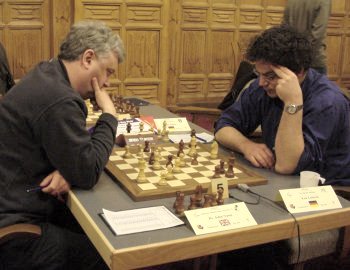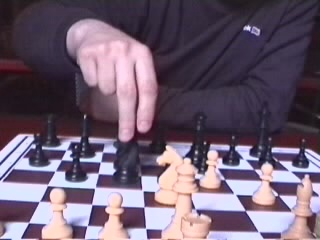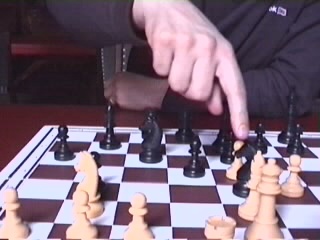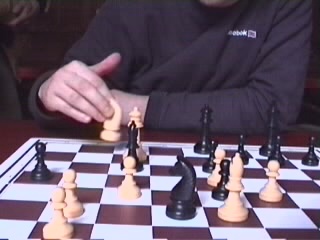

I was quite surprised to be playing Eric at all, because he didn't play yesterday's
match. He was a kind of a surprise player who was parachuted in for today's
game.
1.e4 e6
He also surprised me by playing the French defence. I always thought of
him as someone who plays the Caro Kann or the Sicilian.
2.d4 d5
3.Nc3 Nf6
4.e5 Nfd7
5.f4 c5
6.Nf3 Nc6
7.Be3 cxd4
8.Nxd4 Bc5
9.Qd2 a6
This is a very well-known position, and the most common move here is for
White to castle. But since he is not a regular French player I thought I would
confuse him by playing something a little bit unusual.

10.g3 I played a move
that has been used by Kasparov on at least one occasion. I suspect that Kasparov
won't be playing this move 10.g3 regularly, but even if he plays it only once
it can't be a really stupid move. So I thought it was probably okay to play
it. The idea is that instead of castling queenside White also leaves open the
option of also possibly castling kingside.
10...0-0 11.Bg2
Now White can castle on either side, but more likely he's going to caslte
kingside, having spent two tempi on g3 and Bg2
11...Bxd4 12.Bxd4
b5 I was somewhat surprised
by this move, which allows me to retain my dark-square bishop, which can become
a rather powerful piece - in fact later in the game it does become rather strong.
The alternative would have been for him to exchange on d4 in this position,
which may be slightly better.
13.Bf2 I decided to
punish him for not exchanging the bishop by keeping it. Now he thought for quite
a long time, because Black has to consider how to get counterplay. He decided
on a plan which involved transferring the knight from d7 to e4. In fact I think
this is quite a good plan. If Black doesn't get some kind of active counterplay
White can consolidate his position, and then the pressure he has on the dark
squares will definitely give him the advantage.
13...Bb7 14.0-0
Qe7 15.Rad1
Rfd8 Now Black is ready
for the knight transfer from d7 to c5 to e4, so White has to consider how to
react to this. In fact I decided to just allow the knight to come to e4 and
to leave it there, play instead to maintain control of the blockading square
d4.
16.Ne2 I played my knight
away from control of e4, but it is heading for d4.
16...Nc5 17.Nd4
Ne4 Both sides executed
their plans and the knight duly arrives on d4.

18.Qe2 Now it's an interesting
position, because Black has this knight on e4, but White can at any moment exchange
it. So Black always has to take into account the possibility of White playing
Bxe4.
18...b4 19.Be3
Keeping my dark-square bishop, but more importantly keeping it on a square
where it will blockade the e-pawn, if White exchanges on e4 later. Because the
one thing White does not want to happen is to exchange on e4, see the black
e-pawn go forward to e3 and be mated along the long diagonal leading to h1.
19...Rac8 I rather expected
him to play 19...Nxd4 followed up by ...a5, with the idea to develop the bishop
on a6.
20.Nb3 I don't have
to take immediately on e4. First of all I improve the position of my pieces
by playing Nb3. Now the bishop diagonal e3-a7 is open, and then if I take on
e4 at some point the knight or bishop can come to c5 or the bishop to b6, which
increases my possibilities.

20...Qc7 This stops
the last of these possibilities, i.e. the bishop going to c6.
21.Bxe4 Since I have
no more useful preparatory move, so I might as well take on e4.
21...dxe4 22.Qc4
Actually White would very much like to exchange queens in this position
because Black has a number of weak pawns, like the pawns a6 and b4 on the queenside,
and the pawn on e4 will become weak. So in an endgame, if you imagine that all
the queens and rooks are exchanged, White would have a large advantage, because
he would have various possibilities to attack the queenside pawns, or just to
play the king to e3 and win the pawn on e4.
22...a5 23.Qb5
I think White has a slight advantage in this position and I expected him
to play 22...Qb8, but instead he aimed for a tactical solution to his problems.
23...Rxd1 24.Rxd1
Rd8 This is quite a
tricky idea but in fact it increases White's advantage.
25.Rxd8+ Qxd8
26.Kf2 I think he overlooked
that I could play this move. [ The tactical point is that if I take
on b7 he has 26.Qxb7 Qd1+
27.Kg2 Qf3+
which forces a draw.]

26...Qc8 White has a
large advantage: there is no real danger of perpetual check, Black's queenside
pawns are weak and White's pieces can penetrate on the weak dark squares.
[ The critical point was that if he played 26...Qd1
then I play 27.Nd2 stopping
the check on f3. 27...Qh1
He has to go for counterplay because he was losing a piece here. ( If
he plays 27...Ba8 28.Qa6
I play and win the piece.) 28.Nf1
Qf3+ and after 29.Ke1
the fun's over, he has no more checks, my king is secure and he's just dropping
a piece on the queenside. That is why he could not play 26...Qd1 but instead
had to go for something passive and play 26...Qc8.]
27.Nc5 Ba8
28.Qa6 As I said White
would like to exchange queens
28...Qd8 Now comes a
nice tactical point.
29.Nd7 threatening to
win a piece with Nb6, trapping the bishop. This is actually a very ackward move.
29...b3 He tried to
solve his problems tactically by getting b4 for his knight [ after for
example 29...Ne7 White plays
30.Bb6 and wins the pawn
on a5]
30.axb3 Nb4
attacking the queen and the pawn on c2
31.Qd6 threatening Nf6+,
so he has no time to take the pawn on c2 at the moment
31...Qc8 32.c4
This is useful because it controls the d5 square.
32...Nd3+ 33.Kg1
Bc6 [ The point of
33.Kg1 is that if he plays 33...Nxb2
I go 34.Nb6 Qe8
35.Nxa8 Qxa8
36.c5 and there is no way
for him to stop this pawn, because the white king is ideally placed on g1 to
stop any checks by the black queen, which cannot actually get out in time to
prevent the pawn from promoting. That's why I chose g1 for my king, rather than
some other square.]
34.Nb6 Qe8
35.Qc7 Now there is
a terrible threat of Nc8, followed either by Ne7+ or Qxc6. So again he doesn't
have time to take the pawn on b2
35...h5? I think Black
was losing anyway, because White has an extra pawn and his pieces are extremely
active.

36.Nc8 In fact he has
almost no moves after this. I'm threatening Qxc6.
36...Qd7 This rather
shortend the game [ If he wants to avoid immediate loss of material
the only move is 36...Ba8
but this really speaks for itself. If nothing else I can just play 37.Nd6
and then take the pawn on a5]
37.Qxc6 and after losing
the piece he resigned. 1-0
